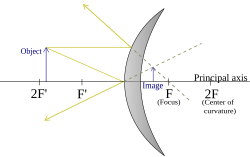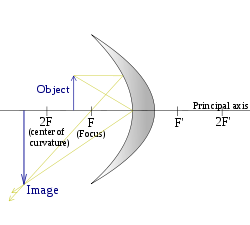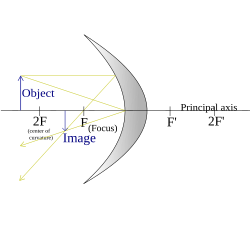Curved mirror

A curved mirror is a
Convex mirrors

A convex mirror or diverging mirror is a curved mirror in which the reflective surface bulges towards the light source.[1] Convex mirrors reflect light outwards, therefore they are not used to focus light. Such mirrors always form a virtual image, since the focal point (F) and the centre of curvature (2F) are both imaginary points "inside" the mirror, that cannot be reached. As a result, images formed by these mirrors cannot be projected on a screen, since the image is inside the mirror. The image is smaller than the object, but gets larger as the object approaches the mirror.
A
Uses of convex mirrors


The passenger-side mirror on a car is typically a convex mirror. In some countries, these are labeled with the safety warning "Objects in mirror are closer than they appear", to warn the driver of the convex mirror's distorting effects on distance perception. Convex mirrors are preferred in vehicles because they give an upright (not inverted), though diminished (smaller), image and because they provide a wider field of view as they are curved outwards.
These mirrors are often found in the
Convex mirrors are used in some automated teller machines as a simple and handy security feature, allowing the users to see what is happening behind them. Similar devices are sold to be attached to ordinary computer monitors. Convex mirrors make everything seem smaller but cover a larger area of surveillance.
Round convex mirrors called Oeil de Sorcière (French for "sorcerer's eye") were a popular luxury item from the 15th century onwards, shown in many depictions of interiors from that time.
Convex mirror image
The image on a convex mirror is always virtual (rays haven't actually passed through the image; their extensions do, like in a regular mirror), diminished (smaller), and upright (not inverted). As the object gets closer to the mirror, the image gets larger, until approximately the size of the object, when it touches the mirror. As the object moves away, the image diminishes in size and gets gradually closer to the focus, until it is reduced to a point in the focus when the object is at an infinite distance. These features make convex mirrors very useful: since everything appears smaller in the mirror, they cover a wider
| Object's position (S), focal point (F) |
Image | Diagram |
|---|---|---|
|

|
Concave mirrors

A concave mirror, or converging mirror, has a reflecting surface that is recessed inward (away from the incident light). Concave mirrors reflect light inward to one focal point. They are used to focus light. Unlike convex mirrors, concave mirrors show different image types depending on the distance between the object and the mirror.
The mirrors are called "converging mirrors" because they tend to collect light that falls on them, refocusing parallel incoming rays toward a focus. This is because the light is reflected at different angles at different spots on the mirror as the normal to the mirror surface differs at each spot.
Uses of concave mirrors
Concave mirrors are used in
Concave mirror image
Mirror shape
Most curved mirrors have a spherical profile.[7] These are the simplest to make, and it is the best shape for general-purpose use. Spherical mirrors, however, suffer from spherical aberration—parallel rays reflected from such mirrors do not focus to a single point. For parallel rays, such as those coming from a very distant object, a parabolic reflector can do a better job. Such a mirror can focus incoming parallel rays to a much smaller spot than a spherical mirror can. A toroidal reflector is a form of parabolic reflector which has a different focal distance depending on the angle of the mirror.
Analysis
Mirror equation, magnification, and focal length
The Gaussian mirror equation, also known as the mirror and lens equation, relates the object distance and image distance to the focal length :[2]
- .
The sign convention used here is that the focal length is positive for concave mirrors and negative for convex ones, and and are positive when the object and image are in front of the mirror, respectively. (They are positive when the object or image is real.)[2]
For convex mirrors, if one moves the term to the right side of the equation to solve for , then the result is always a negative number, meaning that the image distance is negative—the image is virtual, located "behind" the mirror. This is consistent with the behavior described above.
For concave mirrors, whether the image is virtual or real depends on how large the object distance is compared to the focal length. If the term is larger than the term, then is positive and the image is real. Otherwise, the term is negative and the image is virtual. Again, this validates the behavior described above.
The magnification of a mirror is defined as the height of the image divided by the height of the object:
- .
By convention, if the resulting magnification is positive, the image is upright. If the magnification is negative, the image is inverted (upside down).
Ray tracing
The image location and size can also be found by graphical ray tracing, as illustrated in the figures above. A ray drawn from the top of the object to the mirror
A second ray can be drawn from the top of the object, parallel to the optical axis. This ray is reflected by the mirror and passes through its focal point. The point at which these two rays meet is the image point corresponding to the top of the object. Its distance from the optical axis defines the height of the image, and its location along the axis is the image location. The mirror equation and magnification equation can be derived geometrically by considering these two rays. A ray that goes from the top of the object through the focal point can be considered instead. Such a ray reflects parallel to the optical axis and also passes through the image point corresponding to the top of the object.
Ray transfer matrix of spherical mirrors
The mathematical treatment is done under the paraxial approximation, meaning that under the first approximation a spherical mirror is a parabolic reflector. The ray matrix of a concave spherical mirror is shown here. The element of the matrix is , where is the focal point of the optical device.
Boxes 1 and 3 feature summing the angles of a triangle and comparing to
See also
- Alhazen's problem (reflection from a spherical mirror)
- Anamorphosis
- Concentrated solar power - a method of solar power generation using curved mirrors or arrays of mirrors
- List of telescope parts and construction
References
- ISBN 9781259006449.
- ^ ISBN 0-201-11609-X.
- ^ Venice Botteghe: Antiques, Bijouterie, Coffee, Cakes, Carpet, Glass Archived 2017-03-06 at the Wayback Machine
- ISBN 1-85709-171-X
- ISBN 9788183322904. Archivedfrom the original on 2018-01-18.
- ISBN 9788172541248. Archivedfrom the original on 2018-01-18.
- ISBN 9780849383144. Archivedfrom the original on 2018-01-18.
External links
- Java applets to explore ray tracing for curved mirrors
- Concave mirrors — real images, Molecular Expressions Optical Microscopy Primer
- Spherical mirrors, online physics lab
- "Grinding the World's Largest Mirror" Popular Science, December 1935























